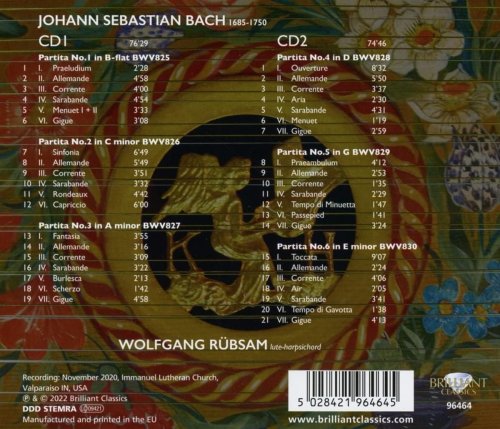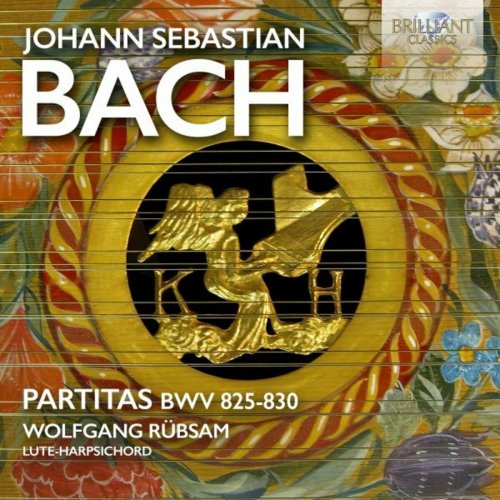
Wolfgang Rübsam - J.S. Bach: Partitas BWV 825-830 (2022)
BAND/ARTIST: Wolfgang Rübsam
- Title: J.S. Bach: Partitas BWV 825-830
- Year Of Release: 2022
- Label: Brilliant Classics
- Genre: Classical
- Quality: FLAC (tracks+booklet)
- Total Time: 151:13 min
- Total Size: 815 MB
- WebSite: Album Preview

Tracklist:
01. Partita No. 1 in B-Flat Major, BWV 825: I. Praeludium
02. Partita No. 1 in B-Flat Major, BWV 825: II. Allemande
03. Partita No. 1 in B-Flat Major, BWV 825: III. Corrente
04. Partita No. 1 in B-Flat Major, BWV 825: IV. Sarabande
05. Partita No. 1 in B-Flat Major, BWV 825: V. Menuet I + II
06. Partita No. 1 in B-Flat Major, BWV 825: VI. Gigue
07. Partita No. 2 in C Minor, BWV 826: I. Sinfonia
08. Partita No. 2 in C Minor, BWV 826: II. Allemande
09. Partita No. 2 in C Minor, BWV 826: III. Corrente
10. Partita No. 2 in C Minor, BWV 826: IV. Sarabande
11. Partita No. 2 in C Minor, BWV 826: V. Rondeaux
12. Partita No. 2 in C Minor, BWV 826: VI. Capriccio
13. Partita No. 3 in A Minor, BWV 827: I. Fantasia
14. Partita No. 3 in A Minor, BWV 827: II. Allemande
15. Partita No. 3 in A Minor, BWV 827: III. Corrente
16. Partita No. 3 in A Minor, BWV 827: IV. Sarabande
17. Partita No. 3 in A Minor, BWV 827: V. Burlesca
18. Partita No. 3 in A Minor, BWV 827: VI. Scherzo
19. Partita No. 3 in A Minor, BWV 827: VII. Gigue
20. Partita No. 4 in D Major, BWV 828: I. Ouverture
21. Partita No. 4 in D Major, BWV 828: II. Allemande
22. Partita No. 4 in D Major, BWV 828: III. Corrente
23. Partita No. 4 in D Major, BWV 828: IV. Aria
24. Partita No. 4 in D Major, BWV 828: V. Sarabande
25. Partita No. 4 in D Major, BWV 828: VI. Menuet
26. Partita No. 4 in D Major, BWV 828: VII. Gigue
27. Partita No. 5 in G Major, BWV 829: I. Praeambulum
28. Partita No. 5 in G Major, BWV 829: II. Allemande
29. Partita No. 5 in G Major, BWV 829: III. Corrente
30. Partita No. 5 in G Major, BWV 829: IV. Sarabande
31. Partita No. 5 in G Major, BWV 829: V. Tempo di minuetta
32. Partita No. 5 in G Major, BWV 829: VI. Passepied
33. Partita No. 5 in G Major, BWV 829: VII. Gigue
34. Partita No. 6 in E Minor, BWV 830: I. Toccata
35. Partita No. 6 in E Minor, BWV 830: II. Allemande
36. Partita No. 6 in E Minor, BWV 830: III. Corrente
37. Partita No. 6 in E Minor, BWV 830: IV. Air
38. Partita No. 6 in E Minor, BWV 830: V. Sarabande
39. Partita No. 6 in E Minor, BWV 830: VI. Tempo di gavotte
40. Partita No. 6 in E Minor, BWV 830: VII. Gigue
Playwright Luise Gottsched, née Kulmus, in 1732 wrote a letter to her future husband, the writer Johann Christoph Gottsched: 'The keyboard pieces sent over by Bach... are as difficult as they are beautiful. Even after playing them ten times, they still seem new to me.' A few years later polymath and Bach's former pupil Lorenz Christoph Mizler offered the following advice regarding these Clavier-Übung I partitas: 'Anyone who has difficulties with keyboard fingering will find it difficult to learn the keyboard pieces written by the famous Mr. Bach in Leipzig'. The name Sinfonia for the first movement in the Partita in C minor is redolent of opening cantata movements and the dotted rhythm of a French overture. The Grave adagio however, is not followed by the fugal fast section you would expect here. This approach was carried out more consistently and stylistically in the Partita in D major, although there the fast section approaches the form of a concerto. Instead, the Grave adagio of the Partita in C minor is followed by a sonata-like movement with an arabesque effect in the upper voice, followed by a lively fugato. As a result, the piece appears in three parts. In contrast, the opening Fantasia in the Partita in A minor is more akin to an invention, showing similarities with the opening section of the second English Suite of the same key. Moreover, since the 17th century, the distinction between the terms 'Praeludium' and 'Praeambulum' was insignificant. Yet Bach's delicately sculpted Praeludium in the B flat major Partita, is stylistically very different from the concerto-like Praeambulum of the Partita in G major. Lastly, the Toccata in the Partita in E minor offers rhapsodic-improvisatory sections framing a fugue after the style of Froberg, whose works for keyboard instruments must have been known to Bach.
Year 2022 | Classical | FLAC / APE
As a ISRA.CLOUD's PREMIUM member you will have the following benefits:
- Unlimited high speed downloads
- Download directly without waiting time
- Unlimited parallel downloads
- Support for download accelerators
- No advertising
- Resume broken downloads


